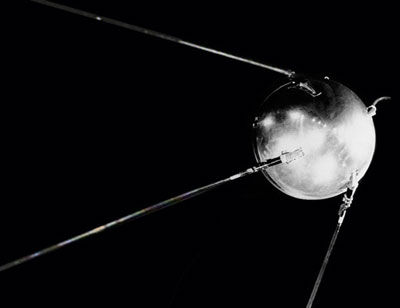Sputnik in perspective: the totalitarian heritageby Taylor Dinerman
|
| On a more basic level, what was it about these totalitarian states that made their leaders more open to the idea of rocketry than the leaders of the democracies? |
What distinguished the Nazis and Communists from previous tyrannies was that they did not base their rule on divine right or on tribal loyalty—though these played a role—but on their own interpretation of “scientific truth”. The Nazis claimed that racial science, derived from a perverted reading of Darwin, gave them, as the master race, the right to rule or wipe out those they considered inferior. The Communists, basing themselves on Marx as well as on Darwin, claimed that “scientific socialism” gave them the right, as the vanguard of the proletariat, to impose their rule on an unwilling world. The Russian answer to this was to joke that, “Our socialist system cannot really be scientific, since real scientists would have tested it on rats first.”
Both systems tried to combine an appeal to archaic nationalist values with a promise that they would own the future. In the case of Russia they tried to pretend that the peasant communes of old Russia (referred to as the “Mir”) made the Russian masses the natural leaders of world communism. The Nazis appeal to Germany’s cultural egotism and a highly selective, not to say propagandistic , vision of modernity runs through their whole ideology.
While Nazi Germany’s political culture was soaked in Wagnerian fantasies about knights and Nordic gods, the Soviets were making movies about medieval Russian heroes, such as Eisenstein’s classic Alexander Nevsky. The psychological need for governments that based their revolutionary legitimacy on the idea that they would inevitably control the future, to the symbols and imagery of a pre-modern mythical past seems, at a minimum, ironic.
While American leaders such as Vannevar Bush, Roosevelt and Truman’s main science advisor, abhorred so-called “push-button” warfare, the totalitarians loved it. Rocket troops require far less technical training than do bomber forces and thus far more time and effort can be put into assuring that they are politically reliable. The problem is that the scientists and engineers who design and build the rockets are not usually the kind of people that tyrannical leaders are comfortable with. Whatever bad things can be said about von Braun—and I expect that Mike Neufeld’s new biography of him will not fail to point them out—he was not a typical Nazi thug.
Korolev, like von Braun, was ready to help kill huge numbers of civilians as part of his duty to his country. That is not an unusual stance in what was the age of total war. He, like many decent and intelligent Soviet citizens, had been sent to the gulag where he had very nearly died. Kolyma, where he spent nearly a year in 1939 and 1940, should be as well known as Auschiwitz: according to the best estimates, by the time it was closed in 1950, nearly two million men, women, and children had perished there, in the Siberian Arctic.
Both the V-2 and the Soviet R-7 will always be associated with concentration camps. The Nazi rocket was built by slave labor at the infamous Dora installation in central Germany. The R-7 owed its beginning to the “sharaga” system of prisons for technical workers and scientists that was so well described by Solzhenitsyn in his novel The First Circle. These regimes found it easy to use slave labor, physical and mental, to accomplish their goals.
The totalitarians were often described as the “have-not powers” in the sense that they lacked the flourishing economies and colonial empires of the main European states, principally Britain and France, that they wished to supplant. As such they were willing to open to new military technologies that might give them an edge.
| What made Sputnik more than just a major step in the exploration of the cosmos and a demonstration of a revolutionary new class of weapon was the reaction in the American and world press. |
They also were ready to use the closed nature of their societies to conduct a large-scale policy of bluff and bluster. The Germans convinced most of the world that they had a very large and well-trained air force in 1937–1938 when in fact it was still in embryo. Likewise, after Sputnik, Khrushchev announced that their rockets were coming off the assembly line “like sausages”, which was, to put it mildly, inaccurate. Totalitarian and authoritarian states are obsessed with the need to simultaneously appear strong and at the same time to claim that they are the weak victims of their enemies.
What made Sputnik more than just a major step in the exploration of the cosmos and a demonstration of a revolutionary new class of weapon was the reaction in the American and world press. Eisenhower understood the technology far better than anyone at the time gave him credit for. What he did not anticipate was that his political foes, both Democratic politicians and in the media, would seize on it to discredit his military policy;, his economic policy, which depended on keeping overall government spending under control; and his education policy, which was basically no different from that of FDR or Harry Truman.
Today space policy is still made largely to achieve the same goals that it was in 1957: to gain military advantage, to earn prestige, to help inspire educational achievement in the hard sciences and engineering, and to advance scientific and technological knowledge. What is different now is that we are beginning to see the development of a genuine profit-seeking industry, and fifty years from now space policy will have changed to reflect this fact.
